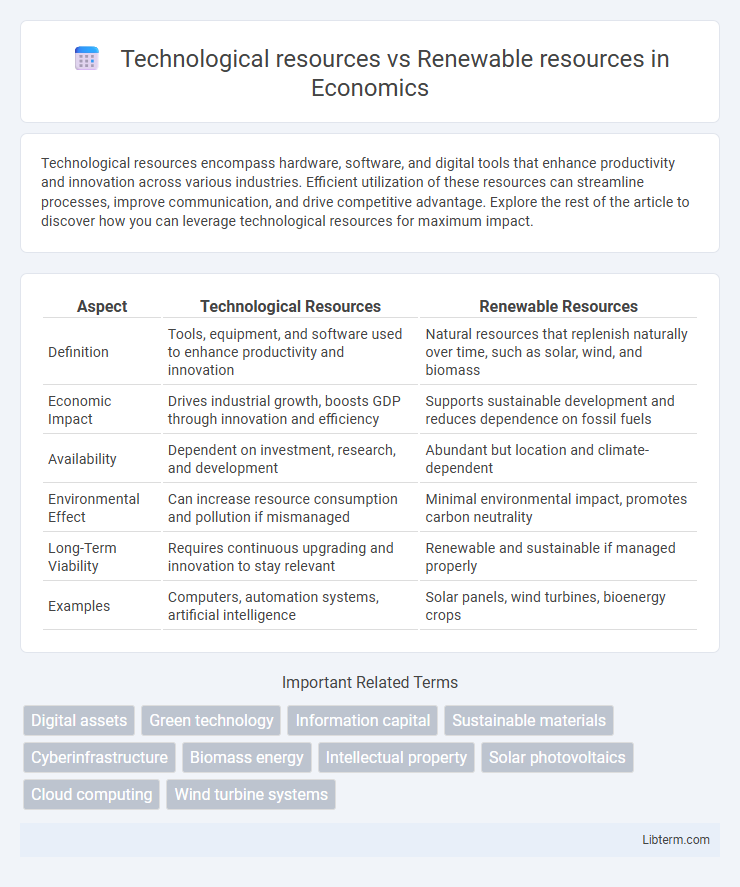Technological resources encompass hardware, software, and digital tools that enhance productivity and innovation across various industries. Efficient utilization of these resources can streamline processes, improve communication, and drive competitive advantage. Explore the rest of the article to discover how you can leverage technological resources for maximum impact.
Table of Comparison
| Aspect | Technological Resources | Renewable Resources |
|---|---|---|
| Definition | Tools, equipment, and software used to enhance productivity and innovation | Natural resources that replenish naturally over time, such as solar, wind, and biomass |
| Economic Impact | Drives industrial growth, boosts GDP through innovation and efficiency | Supports sustainable development and reduces dependence on fossil fuels |
| Availability | Dependent on investment, research, and development | Abundant but location and climate-dependent |
| Environmental Effect | Can increase resource consumption and pollution if mismanaged | Minimal environmental impact, promotes carbon neutrality |
| Long-Term Viability | Requires continuous upgrading and innovation to stay relevant | Renewable and sustainable if managed properly |
| Examples | Computers, automation systems, artificial intelligence | Solar panels, wind turbines, bioenergy crops |
Understanding Technological Resources
Technological resources encompass tools, machines, and systems created through human innovation to improve productivity and efficiency across industries. They include hardware, software, machinery, and infrastructure that support modern economic activities, distinguishing from renewable resources which are naturally replenished like solar, wind, and biomass energy. Understanding technological resources enables strategic investments in research and development, enhancing capabilities to optimize renewable resource utilization and sustainable growth.
Defining Renewable Resources
Renewable resources are natural assets that regenerate through ecological cycles and can be replenished within a human lifespan, such as solar energy, wind power, and biomass. Unlike technological resources, which are human-made tools and innovations used to harness or improve efficiency, renewable resources exist naturally and provide sustainable energy solutions. The continuous availability of renewable resources supports environmental conservation and reduces dependence on finite fossil fuels.
Key Differences Between Technological and Renewable Resources
Technological resources refer to human-made tools, machinery, and systems designed to enhance productivity and innovation, whereas renewable resources are naturally replenished materials like solar, wind, and biomass energy. Key differences include the origin, as technological resources are created through engineering and innovation, while renewable resources are derived from natural processes continuously available. Additionally, technological resources depend on human development and maintenance, whereas renewable resources rely on environmental cycles and natural regeneration.
Types of Technological Resources
Technological resources encompass various tools, machines, and systems such as software, hardware, machinery, and infrastructure that support industrial processes and innovation. These resources include communication technologies, manufacturing equipment, and information processing systems essential for productivity and efficiency. Renewable resources, in contrast, consist of natural assets like solar, wind, hydro, and biomass energy sources that replenish naturally and provide sustainable alternatives to fossil fuels.
Examples of Renewable Resources
Renewable resources include solar energy, wind power, hydroelectricity, geothermal energy, and biomass, all of which are replenished naturally and sustainably. Solar panels convert sunlight into electricity, wind turbines harness wind energy to generate power, and hydroelectric plants use flowing water to produce renewable energy. These examples demonstrate how renewable resources offer environmentally friendly alternatives to fossil fuels, supporting energy needs without depleting natural reserves.
Impact on Environmental Sustainability
Technological resources, such as advanced machinery and automation systems, can increase production efficiency but often lead to higher energy consumption and environmental degradation if reliant on non-renewable energy sources. Renewable resources, including solar, wind, and hydro energy, promote environmental sustainability by reducing greenhouse gas emissions and minimizing ecological footprints. Integrating renewable resources with cutting-edge technology maximizes resource efficiency while significantly lowering adverse environmental impacts.
Role in Economic Development
Technological resources drive economic development by improving productivity, enabling innovation, and creating new markets, with advancements in automation, information technology, and infrastructure playing critical roles. Renewable resources contribute to sustainable economic growth by providing clean energy sources like solar, wind, and hydro power, reducing dependence on fossil fuels and minimizing environmental impacts. The integration of technological innovations with renewable resource management enhances energy efficiency and promotes long-term economic resilience.
Challenges in Resource Management
Technological resources often require complex infrastructure and high initial investments, posing challenges in efficient allocation and maintenance for sustainable usage. Renewable resources face difficulties in variability and unpredictability, such as solar and wind energy fluctuations, which complicate consistent resource management and grid integration. Balancing technological advancement with environmental impact and resource availability remains a critical challenge in optimizing both resource types for long-term sustainability.
Integrating Technology for Renewable Resource Utilization
Integrating technology for renewable resource utilization enhances energy efficiency and maximizes output from solar, wind, and geothermal sources through advanced sensors, smart grids, and AI-driven analytics. Technological innovations enable real-time monitoring and predictive maintenance, reducing downtime and operational costs in renewable energy systems. This synergy between technology and renewable resources drives sustainable energy production and supports global carbon reduction goals.
Future Trends in Resource Innovation
Future trends in resource innovation emphasize the integration of advanced technological resources such as artificial intelligence, nanotechnology, and automation with renewable resources like solar, wind, and bioenergy to enhance efficiency and sustainability. Development of smart grids, energy storage solutions, and sustainable materials is accelerating the transition towards a low-carbon economy. Innovations in recycling technologies and circular economy models are critical for optimizing resource utilization and minimizing environmental impact.
Technological resources Infographic

 libterm.com
libterm.com